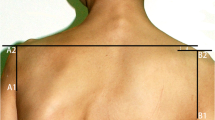Abstract
Purpose
Scapular dyskinesis has been related to acromioclavicular injuries. A rehabilitation protocol has been studied in order to treat scapular dyskinesis, but it has not yet been evaluated. This rehabilitation programme was adopted to improve the shoulder function, thereby improving the scapular dyskinesis in patients with chronic acromioclavicular dislocation.
Method
Twenty-four patients diagnosed with chronic type III acromioclavicular dislocation and scapular dyskinesis that have already been conservatively treated were enrolled in the rehabilitation protocol and analysed. Fourteen of these patients had a Scapular Inferior Coracoid dysKinesis (SICK) Syndrome. The adopted rehabilitation protocol consisted of 12 strengthening and stretching exercises of the scapulae. The final follow-ups were performed after 6 weeks, 6 months and 12 months using clinical measurements of scapular position and clinical evaluation of the scapular motion. In order to evaluate the SICK scapula syndrome, we used the SICK Scapula Rating Scale. The shoulder function was evaluated with a Constant Score and a Subjective Shoulder Value.
Results
After 12 months, the follow-up concluded that the scapular dyskinesis was no longer present in 18/23 patients (78.2 %). SICK scapula syndrome was observed in 4/8 patients with a scapular malposition. The Scapula Rating Scale score in 4 patients with SICK scapula was 7.5 points. After 12 months of rehabilitation, the mean Constant Score and Subjective Shoulder Value grew up to 85 points.
Conclusion
The scapular dyskinesis and SICK syndrome secondary to chronic type III AC dislocation can be treated with the proposed rehabilitation protocol resulting in positive improvements of the shoulder function within 6 weeks; however, patients that do not respond to the rehabilitation programme will not improve with extended rehabilitation time. It is important to advise patients of the specific exercises for the prevention/treatment of scapular dyskinesis in the rehabilitation programme after AC joint dislocation.
Level of evidence
IV.



Similar content being viewed by others
References
Burkhart SS, Morgan CD, Kibler WB (2003) The disabled throwing shoulder: spectrum of pathology. Part III: the SICK scapula, scapular dyskinesis, the kinetic chain, and rehabilitation. Arthroscopy 19:641–661
Constant CR, Murley AHG (1987) A clinical method of functional assessment of the shoulder. Clin Orthop Relat Res 214:160–164
Cools AM, Struyf F, De Mey K, Maenhout A, Castelein B, Cagnie B (2013) Rehabilitation of scapular dyskinesis: from the office worker to the elite overhead athlete. Br J Sports Med. doi:10.1136/bjsports-2013-092148
Gerber C, Fuchs B, Hodler J (2000) The results of repair of massive tears of the rotator cuff. J Bone Jt Surg Am 82:505–515
Gibson MH, Goebel GV, Jordan TM, Kegerreis S, Worrel TW (1995) A reliability study of measurements techniques to determine static scapular position. J Orthop Sports Phys Ther 21:100–106
Gstettner C, Tauber M, Hitzl W, Resch H (2008) Rockwood type III AC dislocation: surgical versus conservative treatment. J Shoulder Elbow Surg 17:220–225
Gumina S, Carbone S, Arceri V, Rita A, Vestri AR, Postacchini F (2009) The relationship between chronic type III acromioclavicular joint dislocation and cervical spine pain. BMC Musculoskelet Disord 10:157–164
Gumina S, Carbone S, Postacchini F (2009) Scapular dyskinesis and SICK syndrome in patients with type III acromioclavicular dislocation. Arthroscopy 25:40–45
Kibler WB (2000) Evaluation and diagnosis of scapulothoracic problems in the athlete. Sports Med Artrhroscopic Rev 8:192–202
Kibler WB, Livingston BP (2001) Closed chain rehabilitation for the upper and lower extremity. J Am Acad Orthop Surg 9:412–421
Kibler WB, McMullen J (2003) Scapular dyskinesis and its relation to shoulder pain. J Am Acad Orthop Surg 11:142–151
Landis JR, Koch GC (1977) The measurement of observer agreement for categorical data. Biometrics 33:159–174
Leroux JL, Thomas E, Bonnel F, Blotman F (1995) Diagnostic value of clinical tests for shoulder impingement syndrome. Rev Rhum Engl Ed 62:423–428
Lizaur A, Sanz-Reig J, Gonzalez-Parreño S (2011) Long-term results of the surgical treatment of type III acromioclavicular dislocations: an update of a previous report. J Bone Jt Surg Br 93:1088–1092
McMullen J, Uhl TL (2000) A kinetic chain approach for shoulder rehabilitation. J Athl Train 35:329–337
Merolla G, De Santis E, Sperling JW, Campi F, Paladini P, Porcellini G (2010) Infraspinatus strength assessment before and after scapular muscles rehabilitation in professional volleyball players with scapular dyskinesis. J Shoulder Elbow Surg 19:1256–1264
Murena L, Canton G, Vulcano E, Cherubino P (2013) Scapular dyskinesis and SICK scapula syndrome following surgical treatment of type III acute acromioclavicular dislocations. Knee Surg Sports Traumatol Arthrosc 21:1146–1150
Nissen CW, Chatterjee A (2007) Type III acromioclavicular separation: results on a recent survey on its management. Am J Orthop 36:89–93
Paletta GA, Warner JJP, Warren RF et al (1997) Shoulder kinetics with two-plane x-ray evaluation in patients with anterior instability or rotator cuff tears. J Shoulder Elbow Surg 6:516–527
Smith TO, Chester R, Pearse EO, Hing CB (2011) Operative versus non-operative management following Rockwood grade III acromioclavicular separation: a meta-analysis of the current evidence base. J Orthop Traumatol 12:19–27
Tauber M, Koller H, Hitzl W, Resch H (2010) Dynamic radiologic evaluation of horizontal instability in acute acromioclavicular joint dislocations. Am J Sports Med 38:1188–1195
Uhl TL, Kibler WB, Gecewich B, Tripp BL (2009) Evaluation of clinical assessment methods for scapular dyskinesis. Arthroscopy 25:1240–1248
Warner JJ, Micheli LJ, Arslanian LE, Kennedy J, Kennedy R (1992) Scapulothoracic motion in normal shoulders and in shoulders with glenohumeral instability and impingement syndrome. A study using Moire topographic analysis. Clin Orthop Relat Res 285:191–199
Wellmann M, da Silva G, Lichtenberg S, Magosch P, Habermeyer P (2013) Instability pattern of acromioclavicular joint dislocations type Rockwood III: relevance of horizontal instability. Orthopade 42:271–277
Wright AA, Wassinger CA, Frank M, Michener LA, Hegedus EJ (2013) Diagnostic accuracy of scapular physical examination tests for shoulder disorders: a systematic review. Br J Sports Med 47:886–892
Author information
Authors and Affiliations
Corresponding author
Rights and permissions
About this article
Cite this article
Carbone, S., Postacchini, R. & Gumina, S. Scapular dyskinesis and SICK syndrome in patients with a chronic type III acromioclavicular dislocation. Results of rehabilitation. Knee Surg Sports Traumatol Arthrosc 23, 1473–1480 (2015). https://doi.org/10.1007/s00167-014-2844-5
Received:
Accepted:
Published:
Issue Date:
DOI: https://doi.org/10.1007/s00167-014-2844-5




